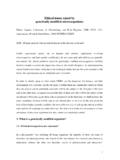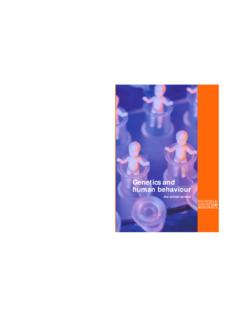Transcription of Ethics, Morality and Animal Biotechnology
1 ethics , Morality ANDANIMAL BIOTECHNOLOGYR oger StraughanETHICS MOR Animal 29/9/00 3:00 pm Page DEVELOPMENTS IN Animal BIOTECHNOLOGY1 - 4 Why are genetically modified animals produced?Why are animals used instead of genetically modified microbes or plants?UK AND ETHICAL CONCERNS5 - 6 How can moral and ethical concerns be evaluated?Why do moral and ethical concerns matter? ETHICS7 - 10 Animal welfare and the moral communitySentiencySpeciesismThe extent of the Animal CONCERNSABOUT Animal BIOTECHNOLOGY11 - 16 Religious concernsProblems with Nature and naturalnessProblems with CONCERNS ABOUTANIMAL BIOTECHNOLOGY17 - 21Is Animal Biotechnology risky? Animal ANNEX23 - 25 References and Acknowledgementsback coverThe Biotechnology and Biological Sciences Research Council (BBSRC) is the UK s leading fundingbody for basic and strategic research in the biosciences in universities and research institutes.
2 It isfunded from the Science Budget of the Government s Office of Science and publishes this document as part of its commitment to promote public awareness anddiscussion of advances in the biosciences and the issues they raise. The views expressed are thoseof the author and are not necessarily those of the document complements ethics , Morality and Crop Biotechnology written by Dr Roger Straughan and the Revd Dr Michael Reiss, and published by BBSRC in has published a leaflet Why Animals are used in Biological Research that outlines the Council s position on some of the issues discussed in this HouseNorth Star AvenueSwindon SN2 1 UHTel: 01793 , Morality and Animal BiotechnologyETHICS MOR Animal 29/9/00 3:00 pm Page 2In general, the phrase Animal Biotechnology covers many well established procedures ofconventional livestock breeding such as performancetesting and the use of artificial insemination, aswell as major developments in reproductivephysiology over recent decades such as in vitrofertilisation (test tube babies) and embryo transfer(surrogacy).
3 Some people would argue that thedomestication of wild animals, which beganseveral thousands of years ago, and the selectivebreeding practices of recent centuries are alsoexamples of , in this booklet we focus mainly onethical, moral and social issues surroundingrelatively recent developments that involve geneticmodification, the direct manipulation of ananimal s genetic make-up. Genetic modification ofanimals was first achieved with mice in 1980, andof cattle, sheep and pigs by about will also consider issues raised by the newtechnology called nuclear transfer. Here, wholenuclei, and the genes which they carry, is the process that was used toproduce the sheep Dolly, and subsequent clonedGENETIC MODIFICATIONSome people imagine that genetic modificationinvariably means moving genes from one species toanother, or adding genes to an organism s normalcomplement.
4 When it comes to considering ethicaland other issues, it can be helpful, however, toremember that genetic modification covers twotypes of activities: Altering the genes normally present in anindividual in such a way that the alteration ispassed on to (at least some of) its descendants. Transferring a gene or genes from one individualto another of the same species, or of a tale of two sheepThe ewe on the left is genetically modified : she carries a copy of a human gene for an enzyme inhibitor called alpha-1-antitrypsin which can be used to treat some lung disorders. Because the sheep carries a copy of a human gene she may be saidto be transgenic . The ewe on the right is Dolly the world s first mammal cloned from an adult cell. She is neither geneticallymodified nor transgenic. Dolly has the same genes as the ewe from which an udder cell was taken and fused with an empty egg to produce It does not involve altering the genes,rather copying them.
5 In this respect it resembleswhat gardeners do when they take cuttings of a plant to propagate outline of how genetic modification and nucleartransfer can be achieved is given on pages developments inanimal biotechnologyWhy are genetically modified animals produced?When considering applicationsof genetic modification it maybe helpful to distinguishbetween: Theoretical ideas about what might bepossible with genetic modification The use of the technology as a tool inlaboratory experiments, for example, tofind out what a particular gene does The commercial production of geneticallymodified animals for use in medical,agricultural or other are five reasons why genetically modifiedanimals are produced:1. To help scientists to identify, isolate andcharacterise genes in order to understandmore about their function and modification can be used to knock outthe activity of a particular gene.
6 By correlatingloss of function with this knock out it ispossible to gain information about the role ofthe gene and the product for which it To provide research models of humandiseases, to help develop new drugs andnew strategies for repairing defectivegenes ( gene therapy ). Animal models of diseases have been used formany years by exploiting naturally occurringmutations in genes, and in-breeding laboratorystrains of animals carrying the mutation. Anexample is a mouse model of DuchenneMuscular Dystrophy. Genetic modification hasbeen used to produce Animal models of manydiseases including mice with predispositionto cancers, and mice with cystic models may be made by knockingout the activity of genes, as describedabove, or by inserting defective inserting additional copies of a geneinto laboratory mice and observing theeffects, scientists have recently confirmedthe role of this gene in a disorder ofhuman babies that is associated withincreased susceptibility to will aid the design of newmedical treatments.
7 Nude mouse: A particular strain of mouse that is hairless andhas a very small number, if any, of a particular type of cell ofthe immune system. The mice are frequently used to maintainhuman tumours which can then be studied more easily. Dueto their genetic make up, the mice do not reject the To provide organs and tissues for use inhuman transplant is a shortage of human donors of hearts,kidneys and other organs for can be genetically modified so thatthey carry copies of the human genes thatcode for proteins that inhibit the immuneresponse to foreign means thatorgans from such animals might escaperejection and so could possibly be used fortransplantation into human To produce milk whichcontains therapeuticproteins; or to alter thecomposition of the milk toimprove its nutritional valuefor human , goats and cattle have beenproduced that make medicallyimportant proteins only in has been achieved byinserting copies of human genesfor these proteins and attachingto them regulatory genes thatmake sure that the inserted geneworks only in the products fromtransgenic animals are already inphase two clinical s PPL Therapeutics is testingalpha-1-antitrypsin purifiedfrom the milk of transgenicsheep for the treatment ofchildren with cystic fibrosis, andthe US company GenzymeTransgenics is testing theeffectiveness of antithrombinIII from goats in preventing blood clotting after modification of some cows couldenable replacement of one or two cow proteins by human-identical proteins.
8 Sothat milk from these cows could be used forpremature human infants who cannot tolerateordinary cows To enhance livestock future genetic modification might enablebreeders both to accelerate the rate ofimprovement in livestock performance, and totake advantage of genes not accessiblethrough conventional selective for improvement include enhanceddisease resistance, for example, to developchickens that resist infection by people who are opposed to genetic modification of animals tend to oppose all research using do we tease out any key moral and ethical issues specificallyassociated with genetic modification?This transgenic ewe makes large quantities of the human protein alpha-1-antitrypsin in hermilk. One of her lambs is also transgenic for this protein, which has potential for treating andrelieving symptoms in lung disorders including cystic fibrosis.
9 Producing human proteins inthis way gets around the problem of costly procedures for separating the components ofblood and the risk of contamination with pathogens such as HIV. In providing founder animals leading to large numbers ofgenetically identical laboratory animals. In providing a more reliable way of producing transgenicanimals, and for reducing the number of animals needed toestablish each transgenic line. In enabling gene targeting in livestock and therefore theability to conduct more sophisticated genetic modificationthan in the past. In helping scientists to identify the genetic contribution todifferent diseases, and so to distinguish betweennature/nurture effects. In facilitating the study of age-related changes in cells, andtheir contribution to increased incidence of conditions such ascancer with age.
10 In providing cells as a source of replacement grafting, forexample, to treat conditions such as leukaemia andParkinson s disease. In Animal breeding, producing multiple copies of the verybest performing animals will mean that the genetic progressachieved in elite herds will be more effectively transferred tothe wider farming community. In genetic conservation. Current methods of conservinggenetic diversity by storing frozen semen and embryos isexpensive and time consuming. Using nuclear transfer, skinbiopsies and even hair follicles might be used as sources ofcells which could then be frozen in liquid nitrogen for longterm are animals used instead of genetically modified microbes or plants?UK regulations regarding transgenicanimalsIn the UK research using transgenic animals is covered bythe same controls as those for other Animal research, Animals (Scientific Procedures) Act production of transgenic animals is covered byrequirements of the Advisory Committee on GeneticModification (ACGM) and the Health and Safety require notification of the work.


